|
 Gymnomyces cristatus Gymnomyces cristatus
BiostatusPresent in region - Indigenous. Endemic
Images (click to enlarge)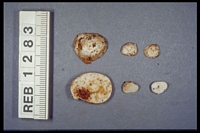
Owner: R.E. Beever | 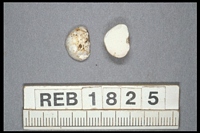
Owner: R.E. Beever | 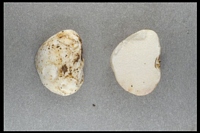
Owner: R.E. Beever | 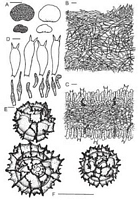
Caption: Fig. 1 Gymnomyces cristatus. A,Basidioma; B, peridiopellis and peridial context; C,
hymenophoral trama and hymenium; D, basidia; E, hymenophora | 
Caption: Fig. 2 Spores of Gymnomyces cristatus. Scale bars = 10 mm. | 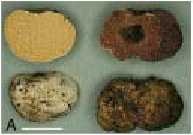
Caption: Fig. 3 A, Gymnomyces cristatus; Scale bar = 10 mm. | 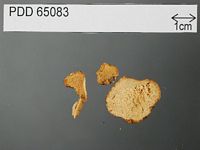
Caption: Dried type specimen
Owner: Herb PDD |
Article: Lebel, T. (2002). Sequestrate Russulales of New Zealand: Gymnomyces and Macowanites. New Zealand Journal of Botany 40(3): 489-509 (http://www.rsnz.org/publish/abstracts.php).
Description: Basidiomata 10-28 x 8-30 mm, globose to subglobose or irregular with an indented
base. Peridial surface dry, smooth or finely felty, white in youth, becoming off-white with
some brown bruising. Context thin, gleba exposed in places. Gleba off-white to pale orange in
youth, becoming orange or dark orangish brown with age, loculate, chambers small, crowded,
giving a firm texture. Stipe absent. Columella absent. Odour and taste faint, pleasant. Latex absent. Peridiopellis
10-35 µm wide, a turf of hyphal tips 2-4 µm diam., and cystidia 10-25 µm x 2-4 µm, fusoid
or ventricose with obtuse or mucronate apices, which may be repent in older specimens giving
the appearance of a compacted cutis. Peridial context 35-86 µm wide, of interwoven, hyaline
hyphae 2-4 µm diam., and scattered, sinuous hyphae 3-6 µm diam., refractive in KOH;
sphaerocysts absent. Endocystidia and laticiferous hyphae absent. Hymenophoral trama 35-55
µm wide, of filamentous, interwoven, slightly gelatinised hyphae 3-4 µm diam., sphaerocysts
and laticiferous hyphae absent. Subhymenium 10-16 µm wide, not well developed, of hyphae
and some irregular cells 5-11 µm diam. Basidia 26-40 x 9-12 µm, clavate to cylindrical,
hyaline, thin-walled, with 2 robust sterigmata 4-9 x 2-4 µm. Cystidia 20-30 x 5-8 µm,
cylindrical, clavate or rostrate with acute or obtuse apices and oily contents, yellow in KOH,
rare, scattered in hymenophoral trama, extending into hymenium. Spores 8-11 µm x 8-11 µm
(9.59 ± 0.69 x 9.36 ± 0.62), Q = 1.02-1.06, globose, orthotropic, symmetrical.
Ornamentation incompletely amyloid, of spines connected by irregular ridges, ± 2-4 high x
1.5-2 µm wide, in a complete, fairly evenly distributed reticulum, givinga crested or flanged appearance to the
spore; ridgesamyloid along edges and partially along faces. Hilarappendix obscure, ± 2-3 µm
long, central,symmetric; plage absent. Spores pale brown to rustycoloured in mass.
Habitat: HABITAT AND DISTRIBUTION: Hypogeous to emergent, solitary or in small groups under
leaf litter in Nothofagus menziesii and N. fusca forests. Fruiting period Mar-Sep
Notes: ETYMOLOGY: The specific epithet refers to the crested or flange-like appearance of the
spore ornamentation, from the Latin cristatum meaning crested. Gymnomyces cristatus is one of three species of Gymnomyces in New Zealand which
have monoorbi-sterigmate basidia, an off-white peridium with some brown patches, and the
gleba becoming orange-brown to brown in older basidiomata. Gymnomyces redolens has a
very different spore ornamentation of isolated spines and warts often connected by low ridges,
and larger hymenial cystidia embedded in the trama. Gymnomyces fuscus has spores
ornamented with isolated spines and generally lacks hymenial cystidia. The crested spore
ornamentation and basidia with two robust sterigmata of Gymnomyces cristatus resemble those
of several collections of Gymnomyces from Australia (Lebel 1998). However, the basidia of G.
cristatus are consistently shorter than the Australian collections, and the gleba has a distinct
orange tint, while the Australian collections generally remain white with some brown patches.
These collections will be described in a paper dealing with new species of
Australian sequestrate Russulales.
|